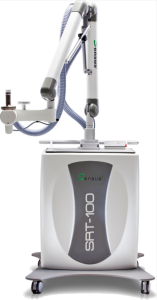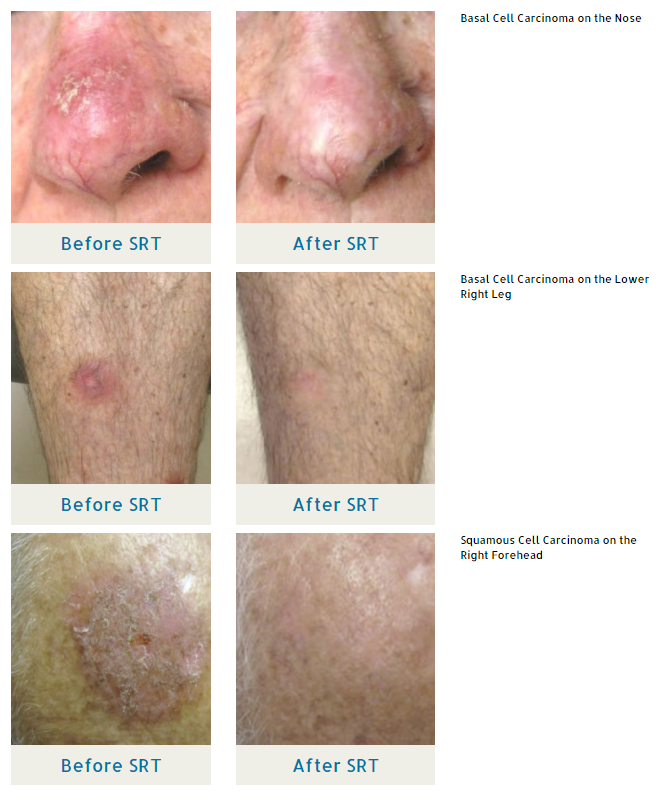Nonsurgical Radiotherapy for Skin Cancer
What Is Superficial Radiation Therapy?
Superficial radiation therapy (SRT) with the SRT-100TM system is a form of nonsurgical radiotherapy for skin cancer. It is a low-dose radiotherapy that has been used to successfully treat non-melanoma skin cancers and keloids for over 50 years. Because the superficial x-rays used in the procedure concentrate radiation on the skin’s surface, the treatment is safe, non-invasive, painless and can be performed onsite in your doctor’s office.
Find This Service Near You
What Conditions Does Superficial Radiation Therapy Treat?
Superficial Radiation Therapy is a low-dose radiation therapy most often used to treat common non-melanoma skin cancers such as basal cell carcinoma and squamous cell carcinoma, as well as keloids. This type of superficial radiotherapy is non-surgical — it goes no deeper than the thickness of the skin — and is virtually painless. There is little to no scarring with SRT, no downtime, and the cure rate is over 95%.
Basal cell carcinoma is the most common type of skin cancer. Almost one million new cases are diagnosed in the U.S. each year and up to 30% of Caucasians may develop basal cell carcinoma during their lifetime. Lesions can be pink, black or brown or look like a shiny pink or red patch on your skin. Typically, these carcinomas are fragile and bleed easily.
Squamous cell carcinoma, the second most common form of skin cancer, develops in the squamous cells that make up the outer layer of skin. Most likely to be found on areas of the skin most exposed to the sun such as the arms, hands or face, squamous cell carcinoma often looks like a firm red nodule, a flat sore with a scaly crust or a new sore or raised area on an old scar or ulcer. There are an estimated 700,000 cases of squamous cell carcinoma diagnosed in the U.S. each year.
A keloid is a growth of extra scar tissue where the skin has healed after an injury. Keloids are caused by the overproduction of collagen as the skin tries to repair itself after a wound, burn, cut or even acne lesion, ear piercing or chickenpox. The keloid itself can be flesh-colored, pink or red in color and is usually raised, lumpy or ridged. Many keloids continue to grow over time. When used to treat keloids, SRT has a success rate of up to 90%.
Advantages of Superficial Radiation Therapy
Superficial Radiation Therapy is non-surgical and does not require the use of an anesthetic. During an SRT-100 treatment, the x-ray is directed toward the lesion by placing an applicator cone over the targeted area. Once the treatment begins, it takes approximately 90 seconds to deliver the therapy.
Patients are required to attend multiple sessions. How many sessions will be determined by your doctor. The treatment itself is painless, but most patients notice some skin redness by the end of the first week’s treatment.
After treatment, the skin will form a protective scab and the new healthy skin will develop underneath.
Before/After
What You Should Know About SRT-100TM
Superficial Radiation Therapy with the SRT-100 has been cleared by the FDA for whole body treatment of skin cancer and keloid scars in conjunction with surgery.
Because it is a non-invasive procedure, there is no need for reconstructive surgery post treatment and when used to treat basal cell and squamous cell carcinomas, the cure rate is between 95% and 98%.
How long is a typical treatment?
Depending on the treatment protocol your doctor chooses for your particular case, you may be required to have several treatments per week for up to several weeks. Each treatment can last as long as 50 seconds.
Is the SRT-100 a safe treatment option?
The SRT-100 is proven technology to treat non-melanoma skin cancers, actinic keratosis and Kaposi’s sarcoma. It is safe and effective and used by dermatologists and radiation oncologists all over the world.
What should I expect from my SRT-100 treatment?
The SRT-100 doesn’t harm surrounding or underlying healthy tissue while targeting only the cancer. As a result, you will experience the same results as surgery but without the pain, anesthesia, cutting, bleeding, stitching and scarring.
*Results may vary by individual


